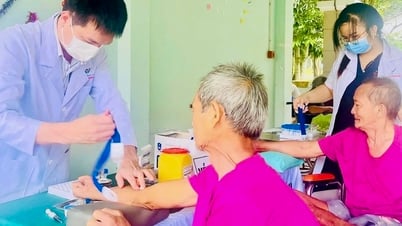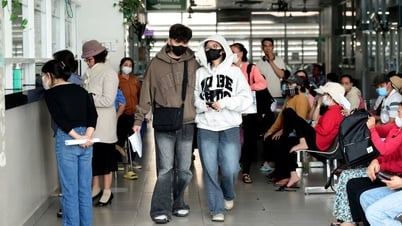Drug allergy rash
Mr. LAT (48 years old, residing in Hanoi ) visited Medlatec Tay Ho General Clinic with a widespread red rash on his body, accompanied by skin lesions in the genital area.
These symptoms appeared after he took antibiotics and painkillers containing paracetamol, prescribed after wisdom tooth extraction surgery. Notably, a similar phenomenon had occurred 2 years ago when he took cold medicine.
At the clinic, through clinical examination, the doctor noted a condition of dark red rash with clear boundaries, 2-5cm in size, distributed in the neck, abdomen, genitals and thighs; the lesions were not accompanied by itching or pain, and did not spread deep under the skin. In addition, test results showed that the patient's blood IgE index was abnormally high - a typical sign of an allergic reaction.
Based on clinical symptoms and paraclinical results, Mr. T. was diagnosed with fixed erythema pigmentosa - a specific type of allergic reaction that recurs in the same location on the body when exposed to the allergen again, in this case paracetamol.
The patient was immediately asked by the doctor to completely stop taking any medications containing paracetamol. At the same time, Mr. T. was prescribed outpatient treatment to control skin damage and avoid complications.
Dr. Nguyen Thu Trang - Dermatology Specialist, Medlatec Tay Ho Clinic said that fixed erythema pigmentosa is a specific type of skin allergic reaction to drugs, characterized by skin lesions that recur in the same location every time the patient is exposed to the drug causing the allergy. The disease can easily be confused with other dermatological diseases if not properly diagnosed and treated promptly.
According to doctors, the disease often appears after taking some common medications such as pain relievers and fever reducers (especially paracetamol), antibiotics (sulfonamides, tetracyclines...), anticonvulsants, or over-the-counter cold medications.
Regarding drug allergy symptoms, patients may see dark red patches with clear edges, a few centimeters in size, sometimes accompanied by blistering, mild itching, or no itching. The lesions often appear on the lips, genitals, inner thighs, hands, abdomen... and will recur in the same location every time the allergenic drug is used again. After the lesions heal, they often leave behind long-lasting dark hyperpigmentation (chroma) marks.
Be careful when using non-prescription drugs
Nowadays, the situation of people arbitrarily buying and using non-prescription drugs is becoming more and more common, especially cold, pain, and fever-reducing drugs such as paracetamol or combination antibiotics.
Many people have the habit of "acting as their own doctor" without consulting a doctor/pharmacist, which carries a high risk of adverse reactions, including drug allergies that cause liver and kidney damage and dangerous antibiotic resistance.
Seemingly "harmless" ingredients such as paracetamol found in many cold, fever, and pain medications can still cause serious allergic reactions, typically erythema multiforme.
This case shows that not knowing the ingredients of the drug and having a history of allergies can lead to skin damage throughout the body, sensitive areas and seriously affect the quality of life.
Specialist Doctor I Nguyen Thu Trang recommends that to protect your health, people need to carefully read the ingredients of the medicine before using it, especially if you have a history of allergies. People should not arbitrarily use many types of medicine at the same time if they do not know the interactions; always consult a doctor/pharmacist when needing to use medicine for a long time, or having unusual symptoms after taking the medicine.
"From the above case, everyone needs to keep information about the drugs that have caused allergies to inform the doctor during the next medical examination," said Dr. Trang.
In addition, when signs such as unusual redness, itching, swelling, or difficulty breathing appear after taking the drug, people need to quickly go to a medical facility for timely examination and treatment.
The first line of treatment for erythema pigmentosa is to immediately stop using the offending medication. Your doctor may prescribe topical anti-inflammatory medications or antihistamines if necessary.
In particular, it is important that patients be advised to avoid reusing the relevant medication, as each relapse can cause the lesion to spread, or cause more serious complications.
Source: https://nhandan.vn/canh-bao-dau-hieu-di-ung-thuoc-khi-noi-ban-toan-than-post889114.html


























![[Video] Russian Film Week in Vietnam 2025](https://vphoto.vietnam.vn/thumb/402x226/vietnam/resource/IMAGE/2025/6/28/c4c3a7980264492ab542dc63c5d9c0c0)











































































Comment (0)